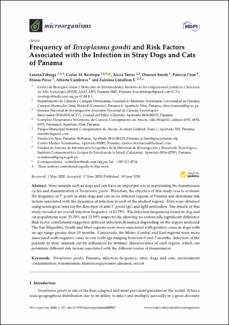Mostrar el registro sencillo del ítem
Frequency of Toxoplasma gondii and Risk Factors Associated with the Infection in Stray Dogs and Cats of Panama
| dc.contributor.author | Fábrega, Lorena | |
| dc.contributor.author | Restrepo, Carlos M. | |
| dc.contributor.author | Torres, Alicia | |
| dc.contributor.author | Smith, Diorene | |
| dc.contributor.author | Chan, Patricia | |
| dc.contributor.author | Pérez, Dimas | |
| dc.contributor.author | Cumbrera, Alberto | |
| dc.contributor.author | Caballero E., Zuleima | |
| dc.date.accessioned | 2020-06-27T00:13:15Z | |
| dc.date.available | 2020-06-27T00:13:15Z | |
| dc.date.issued | 2020-06-19 | |
| dc.identifier.other | doi:10.3390/microorganisms8060927 | |
| dc.identifier.uri | http://repositorio-indicasat.org.pa/handle/123456789/125 | |
| dc.description | Stray animals such as dogs and cats have an important role in maintaining the transmission cycles and dissemination of Toxoplasma gondii. Therefore, the objective of this study was to evaluate the frequency of T. gondii in stray dogs and cats in six different regions of Panama and determine risk factors associated with the dynamics of infection in each of the studied regions. Data were obtained using serological tests for the detection of anti-T. gondii IgG and IgM antibodies. The results of this study revealed an overall infection frequency of 23.73%. The infection frequencies found in dog and cat populations were 25.70% and 21.93% respectively, showing no statistically significant difference. Risk factor correlations suggested different infection dynamics depending on the region analyzed. The San Miguelito, North and West regions were more associated with positive cases in dogs with an age range greater than 13 months. Conversely, the Metro, Central and East regions were more associated with negative cases in cats with age ranging between 0 and 5 months. Infection of the parasite in stray animals can be influenced by intrinsic characteristics of each region, which can potentiate different risk factors associated with the different routes of transmission. | en_US |
| dc.description.abstract | Stray animals such as dogs and cats have an important role in maintaining the transmission cycles and dissemination of Toxoplasma gondii. Therefore, the objective of this study was to evaluate the frequency of T. gondii in stray dogs and cats in six different regions of Panama and determine risk factors associated with the dynamics of infection in each of the studied regions. Data were obtained using serological tests for the detection of anti-T. gondii IgG and IgM antibodies. The results of this study revealed an overall infection frequency of 23.73%. The infection frequencies found in dog and cat populations were 25.70% and 21.93% respectively, showing no statistically significant difference. Risk factor correlations suggested different infection dynamics depending on the region analyzed. The San Miguelito, North and West regions were more associated with positive cases in dogs with an age range greater than 13 months. Conversely, the Metro, Central and East regions were more associated with negative cases in cats with age ranging between 0 and 5 months. Infection of the parasite in stray animals can be influenced by intrinsic characteristics of each region, which can potentiate different risk factors associated with the different routes of transmission. | en_US |
| dc.language.iso | eng | en_US |
| dc.rights | info:eu-repo/semantics/openAccess | |
| dc.subject | Toxoplasma gondii | en_US |
| dc.subject | Panama | en_US |
| dc.subject | infection frequency | en_US |
| dc.subject | stray dogs and cats | en_US |
| dc.subject | environment contamination | en_US |
| dc.subject | transmission | en_US |
| dc.subject | immunosuppressive diseases | en_US |
| dc.subject | oocyst | en_US |
| dc.title | Frequency of Toxoplasma gondii and Risk Factors Associated with the Infection in Stray Dogs and Cats of Panama | en_US |
| dc.type | info:eu-repo/semantics/article | en_US |
| dc.type | info:edu-repo/semantics/publishedVersion |

